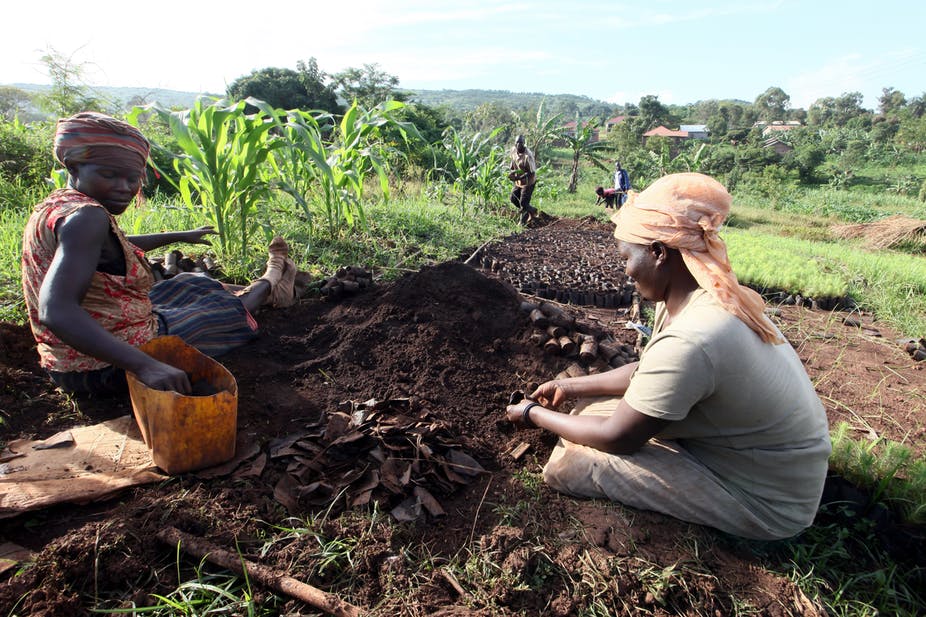The quality of purchased seeds, such as maize, groundnuts, and others, is a major concern in Uganda.
Evidence from recent studies indicates that farmers all over the country have been slow to adopt improved seeds, such as those that protect against drought. Farmers prefer to use seeds they’ve saved from the last season; these are generally of poor quality and don’t protect against weather problems. This suggests that, for Uganda’s farmers, the cost of improved seeds – which are more expensive than home-saved seeds – outweighs any of the benefits.
Farmers are also concerned about the quality of agricultural inputs like fertilizer, seeds, and pesticides. They worry about the potential for these to be adulterated and contaminated. For example, a recent study found that a bag of fertilizer picked at random had only half of the nitrogen content it should. This meant there was little value to using it. The authors also looked at yields from improved maize seeds and discovered a similar situation.
One reason that’s widely cited for low yields is deliberate adulteration of seeds by sellers along the supply chain. The assumption is that sellers deliberately introduce grains or even stones into bags of seed to increase the weight. When the farmer uses these seeds, most don’t germinate. However, no one has ever identified adulteration – it’s simply assumed this is what is causing the problem.
This means that agricultural policy has tended to focus on certification of seeds, including labeling at the source, e-verification, and requiring bags that are not easy to open until the farmer has them. But little effort has been made to improve the quality control of the seed supply chain as a whole, including transportation networks and storage at the end seller.
Uganda’s certification and oversight of seeds has proven inadequate for ensuring that farmers obtain good quality inputs. Neither seed companies nor input shops are well regulated, and market failures have emerged – meaning that the access to optimal quality seeds is still very limited.
Our project expands on the recent work of researchers looking at the quality of agricultural inputs in Africa. To diagnose where quality issues crop up in Uganda, we explored 21 varieties of maize across the supply chain. What we found is that quality, rather than genetic purity, appears to be the main problem. The results are consistent with mishandling and poor storage of seeds.
What our tests found
To collect a representative sample of seeds – as if an actual farmer would have purchased those seeds – we employed a mystery shopper approach. A well-trained team of enumerators self-identified as farmers and purchased seeds from a census of companies at all levels of the supply chain, across three districts in northern Uganda and the capital, Kampala.
The seed samples were then sent to testing facilities in Uganda for purity and performance examination. To identify how genetically similar the seeds were to each other (or in other words, to screen if any seed was adulterated or contaminated), the sample of seeds was shipped to a laboratory in Australia to test for genetic purity.
Seeds were tested on three main indicators. First were DNA tests for genetic purity. Second was a physical test for the percentage of the seed containing stones, dirt, or sand. Last came germination tests – defined as the percentage of seeds that can germinate normally under standard conditions. Vigor tests determined the percentage of seeds able to germinate under sub-optimal conditions and after storage, while moisture tests determine how much water has gotten into the seeds, which leads to lower quality germination.
We did not find evidence of serious seed adulteration by sellers. Instead, we find high levels of seed genetic and physical purity across all levels of the supply chain. Seed samples collected are genetically very similar to each other, and on average presented good physical purity (above 99 percent), or good content of pure seeds (and absence of inert matter or dirt, sand, stones, sticks, and stems.)
Poor handling
Results from tests of vigor and moisture content, combined with high levels of DNA similarity, lead us to believe that the causes of low quality are most likely due to poor management in the downstream levels of the supply chain – wholesalers and retailers – that create poor storage conditions.
Monitoring mechanisms, collective action by stakeholders, and further exploration on seeds during storage and transportation are key for better seeds. Although rules are in place, few resources are available for regulators, meaning that currently seed monitoring is almost non-existent.
On top of seed certification, implementing complementary mechanisms, such as regular quality control inspections, is key.
Future evidence is needed
A note of caution is needed for these results. We were only able to trace the supply chain of maize in one year, and across three districts, plus Kampala. The results are potentially limited in their application to other crops, years, and districts. We are also limited in our sample size, as we were only able to collect 120 samples in total.
A replication of this proof of concept is needed in different regions, seasons, and years to confirm the absence of counterfeit seeds more broadly. We also recommend further studies on the practices and conditions during seed storage and transportation. Future evidence is needed to determine conclusively what is driving low quality seeds in Uganda.
If the results we obtained can be generalized, it is possible they could significantly change the way policy makers approach the issue of low quality seeds in Uganda. If adulteration is not the problem, but instead storage and transportation are the major constraints to quality, money currently being spent on certification processes could be better spent. Future work will need to confirm this interpretation is in fact true.
Originally published in The Conversation.



